#camera vision sensor
Explore tagged Tumblr posts
Text
How do you take a photo of time?
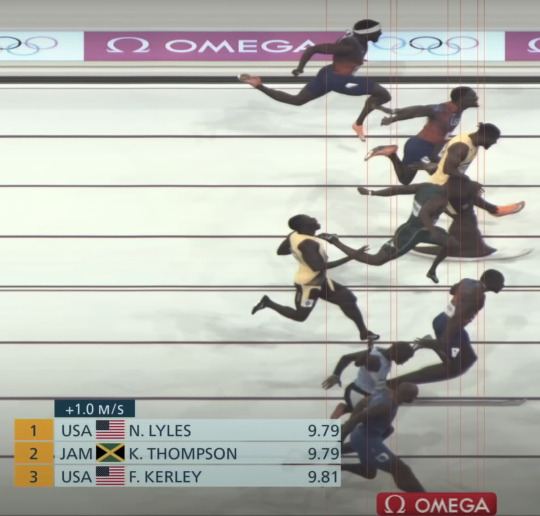
I've been watching the track events at the Olympics since I was a wee lad. It was a tradition in our family. We'd gather around our ancient low-definition 19 inch CRT television and watch tiny blobs compete against other tiny blobs and root for our country.
It was a bit like watching YouTube on your phone in 144p.
Several heroes emerged.
Jackie Joyner-Kersee was amazing.

You can't forget about Flo-Jo.

And then the Olympics decided NBA players were allowed in the competition.
Which formed... The Dream Team.
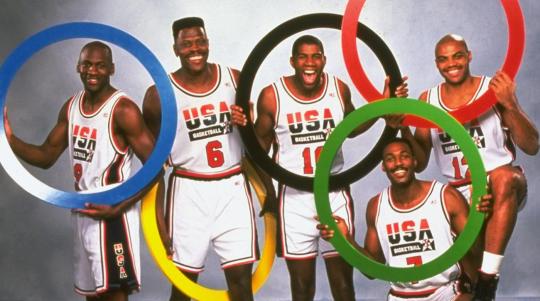
Was this fair?
Well... they won each game by an average of 44 points.
So... no. It was not fair.
Though it became more fair as time went on.
But, umm... yeah. The other teams looked like the Washington Generals and the US looked like the Harlem Globetrotters if they stopped screwing around half of the game.
But my absolute favorite Olympian was a runner named Michael Johnson.

He was cool as heck.
For one thing... gold shoes.
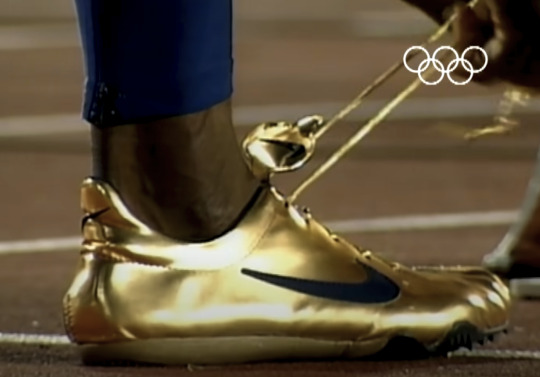
But he also had this crazy, upright, Tom Cruise-ish sprinting style that just made him look like a running robot on the track.

And in the 1996 Atlanta games he just trounced EVERYONE. I mean, it wasn't even close.
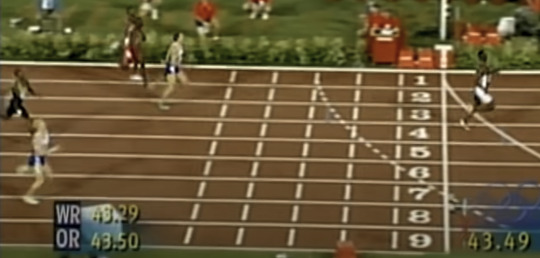
Yikes. Those losing blobs are probably really embarrassed.
Last night I decided to invigorate my nostalgia and watch the track events again. And I got to see one of the wildest races in history.
It didn't even last 10 seconds but it was one of the most exciting sporting events I've ever witnessed. Almost every runner won the race.
After I saw that initially, I was like... who the heck won???
Even in slow motion I wasn't sure.
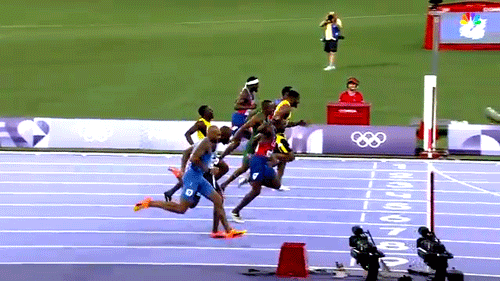
This was one of the closest finishes in history. There has never been a race where all 8 runners were within this margin.
The arena was silent as the winner was being confirmed. The runners just kind of paced around waiting for official word. My best guess was the Jamaican runner, Kishane Thompson. But then the loudspeaker announced Noah Lyles.

The last tiny morsel of American pride burst out of me with a big "Wooooo!"
I forgot what it was like to be proud of my country. I wish it happened more often. But this young man, despite being last place in the first 3rd of the race, turned on the afterburners and won in a photo finish.
And that's when my inner nerd took over.
Because when they showed the photo finish image, it looked super weird.
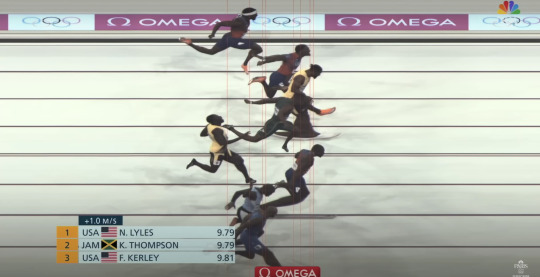
Why is the track white?
Why do all of the runners look all warpy like that QWOP game?

So I went down a research rabbit hole to figure this out.
Photo finishes are actually fascinating. The first photo finish captured the end of a horse race in 1890. But that was mostly luck and timing. The actual photo finish mechanisms weren't used until 1937.
Originally they would film the finish line through a physical slit.

And the first horsie head that appeared in that slit would be the winner. This technology ended a huge aspect of corruption in horse race fixing almost overnight.
But we have come a long way since then. And I'd like to introduce you to the Omega Scan 'O' Vision Ultimate.
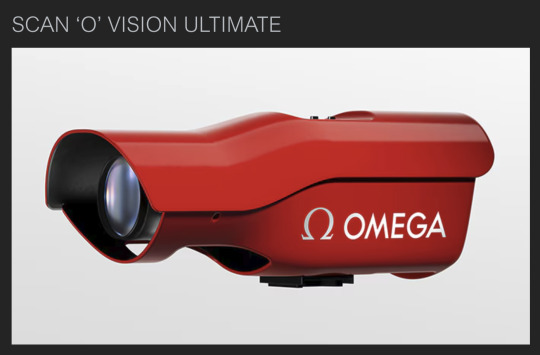
This slow motion camera sits fixed on the finish line of every race. The concept of the photo finish has remained remarkably similar to the 1930s approach. The camera sensor is specially designed to only record a vertical slit.
Only the finish line itself is actually captured.
And because it limits what it records to only that slit, it can capture 40,000 frames per second to get amazing temporal resolution.
So why don't the photo finishes just look like, well... this?

That is because the camera takes a picture of time more-so than dimensional space. I guess it would be more accurate to say it *assembles* a picture of time.
As the runners cross the finish line, the camera combines all of the little strips of pictures into a single image.
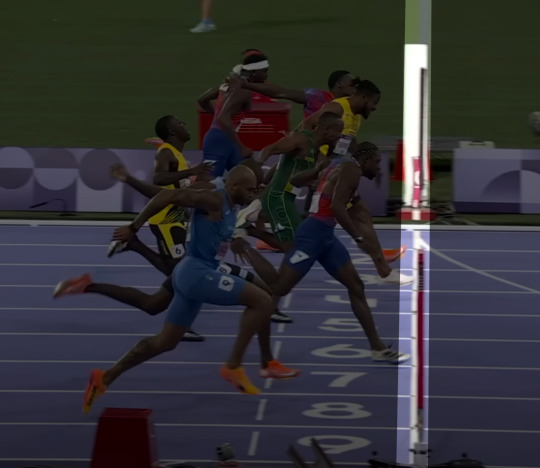





It's almost like if you tried to reassemble a piece of paper after it had been shredded.
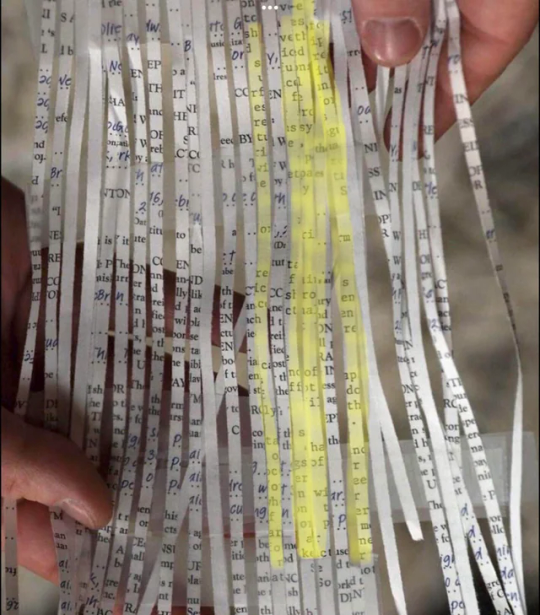
Imagine each strip of paper is a picture of ONLY the finish line, just at a slightly different point in time.
What if someone stopped on the finish line and didn't move... what would that look like?

Once they got there, the same part of their body would just be repeated.
So the right side of the photo finish picture represents earlier in time and it just assembles the image strip by strip as time passes and you literally get a picture of time itself.
NEAT!
Okay, but how do they determine the winner from the photo finish?
I mean, that shoe looks like it is ahead of Noah Lyles!
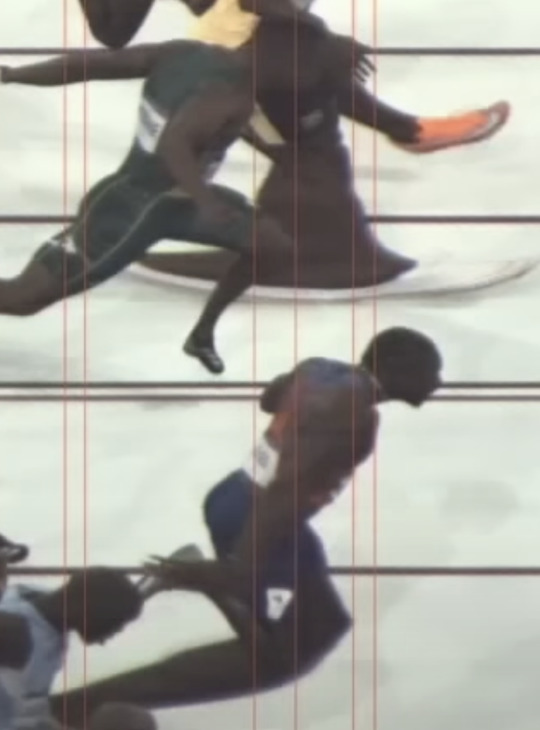
Clavicles!
The IAFF rules state the foremost part of the torso must cross the finish line first. And the endpoint of the torso is the outer end of the clavicle.
So if you get this bone across the finish line first, you win the race.
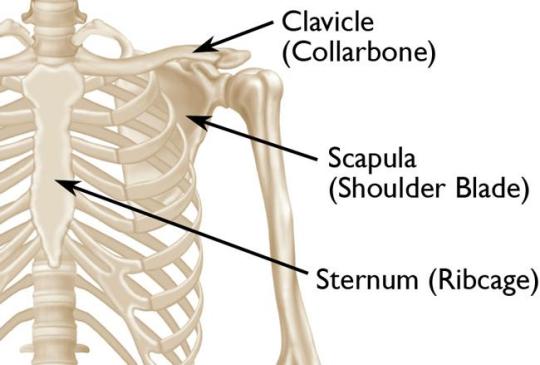
Two more fun facts!
The start of the race is actually just as carefully timed as the end of the race. There are sensors in the starting blocks of each runner.
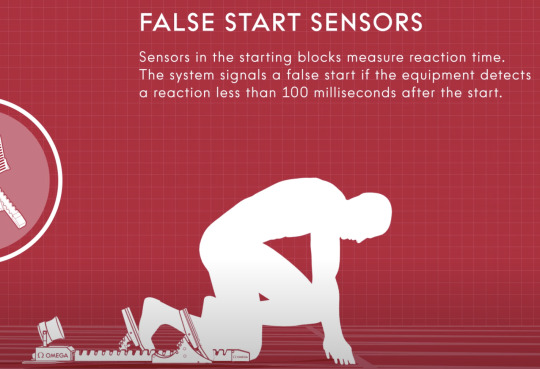
The starting gun also has an electronic sensor.
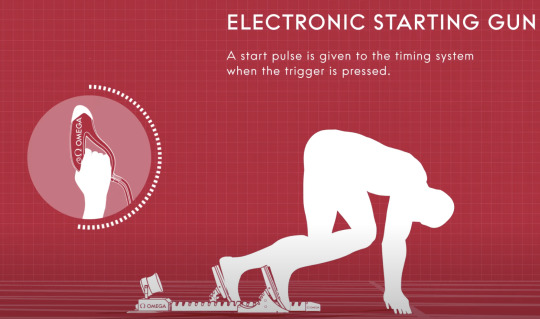
They have determined the fastest a human can react to the sound of a gun is roughly 100 milliseconds. So if you start running before 100 milliseconds they know you didn't actually hear the gun, you just got antsy and started running too early.
And the final fun fact...
Did you notice the Omega logo at the top of the photo finish?

That isn't superimposed or added after the fact. That is captured by the camera.
But if this image is composed only of tiny little slivers, how did they get the Omega logo to show up?

That is a little display. And it is synchronized with the Scan 'O' Vision Ultimate to show a little sliver of the Omega logo for each frame captured.

So when the final image is stitched together, it looks like a cohesive logo at the top of the photo.
Pretty clever, Omega!
26K notes
·
View notes
Text

Hubble Space Telescope: Exploring the Cosmos and Making Life Better on Earth
In the 35 years since its launch aboard space shuttle Discovery, the Hubble Space Telescope has provided stunning views of galaxies millions of light years away. But the leaps in technology needed for its look into space has also provided benefits on the ground. Here are some of the technologies developed for Hubble that have improved life on Earth.

Image Sensors Find Cancer
Charge-coupled device (CCD) sensors have been used in digital photography for decades, but Hubble’s Space Telescope Imaging Spectrograph required a far more sensitive CCD. This development resulted in improved image sensors for mammogram machines, helping doctors find and treat breast cancer.

Laser Vision Gives Insights
In preparation for a repair mission to fix Hubble’s misshapen mirror, Goddard Space Flight Center required a way to accurately measure replacement parts. This resulted in a tool to detect mirror defects, which has since been used to develop a commercial 3D imaging system and a package detection device now used by all major shipping companies.

Optimized Hospital Scheduling
A computer scientist who helped design software for scheduling Hubble’s observations adapted it to assist with scheduling medical procedures. This software helps hospitals optimize constantly changing schedules for medical imaging and keep the high pace of emergency rooms going.

Optical Filters Match Wavelengths and Paint Swatches
For Hubble’s main cameras to capture high-quality images of stars and galaxies, each of its filters had to block all but a specific range of wavelengths of light. The filters needed to capture the best data possible but also fit on one optical element. A company contracted to construct these filters used its experience on this project to create filters used in paint-matching devices for hardware stores, with multiple wavelengths evaluated by a single lens.
Make sure to follow us on Tumblr for your regular dose of space!

2K notes
·
View notes
Text
Choosing the Right Machine Vision Lens: A Comprehensive Guide
Machine vision technology has rapidly evolved, and selecting the appropriate lens for your application is now more critical than ever. With the wide variety of lenses available, choosing the right one can be a daunting task. However, by considering a few key factors, you can make an informed decision that will significantly impact the performance and image quality of your machine vision system. In this comprehensive guide, we will delve into the various aspects of selecting the perfect machine vision lens to meet your specific needs.
Fixed, Varifocal, or Zoom:
The first decision to make when choosing a machine vision lens is whether you need a fixed, varifocal, or zoom lens. Each of these options has its own set of advantages and is suited for different applications.
Fixed Lenses: Fixed lenses are an excellent choice when you have a consistent working distance and require sharp, high-quality images. These lenses have a fixed focal length, meaning they do not offer the flexibility to adjust the zoom or focus. If your application involves stationary objects or a controlled environment where the working distance remains constant, a fixed lens is a cost-effective and reliable choice.
Varifocal Lenses: Varifocal lenses are designed for situations where the subject is in motion or may require frequent refocusing. These lenses offer the flexibility to adjust the focal length and focus, making them ideal for applications that involve objects at varying distances. Varifocal lenses can save time and effort by allowing you to adapt to changing conditions without replacing the lens.
Zoom Lenses: Zoom lenses are the most versatile of the three options. They can adapt to distant subjects by changing the focal length, providing you with the ability to zoom in or out as needed. This adaptability is particularly valuable in applications where the working distance is not constant, or when you need to capture fine details in both nearby and faraway subjects. While zoom lenses offer flexibility, they are typically larger and more complex, which can result in a higher cost.
Focal Length and Focus:
The focal length of a machine vision lens plays a crucial role in determining the field of view (FOV) and the magnification of the image. Understanding how to choose the right focal length is essential for capturing the desired image.
Field of View (FOV): The focal length directly affects the FOV. A longer focal length will provide a narrower FOV, which means the lens will capture a smaller area with greater detail. Conversely, a shorter focal length lens will result in a broader FOV, allowing you to capture a larger area but with less magnification. When selecting the focal length, consider the size of the objects or areas you need to capture in your application.
Magnification: In addition to FOV, the focal length also determines the magnification of the image. Longer focal lengths result in greater magnification, making them suitable for applications where fine details are essential. Shorter focal lengths, on the other hand, provide lower magnification but are ideal for applications where capturing a larger area is a priority.
To choose the right focal length for your machine vision lens, you need to have a clear understanding of your application's requirements and objectives. Analyze the size and details of the objects you are inspecting to determine the optimal focal length for your specific case.
Aperture and Lighting:
The relationship between aperture and lighting is critical for achieving the desired depth of field and image quality in machine vision applications.
Aperture: The aperture of a lens controls the amount of light that enters the camera sensor. It is typically represented by an f-number (e.g., f/2.8). A smaller f-number indicates a wider aperture, allowing more light to enter, while a larger f-number means a narrower aperture, which restricts the amount of light. Selecting the right aperture is essential to achieve the desired depth of field.
Depth of Field (DOF): The depth of field is the range within which objects appear acceptably sharp in an image. It is influenced by the aperture size, with wider apertures producing a shallower DOF and narrower apertures providing a deeper DOF. The choice of aperture depends on your application's requirements. If you need to capture fine details in a specific focal plane, a narrow aperture might be suitable. For situations where multiple objects at varying distances must be in focus, a wider aperture may be preferable.
Consider the lighting conditions of your environment, the specific requirements of your application, and the depth of field you need to achieve when selecting the aperture for your machine vision lens.
Resolution and Accuracy:
When it comes to machine vision, resolution and accuracy are paramount. To ensure the best results, you must find a lens that offers the highest resolution for your subject or operation. Consider various factors, including image clarity, application demands, available options, and cost-benefit analysis.
Resolution: Resolution refers to the lens's ability to capture fine details in an image. Higher resolution lenses produce sharper and more detailed images, which can be crucial for applications that require precision, such as quality control and measurements.
Application: The specific application of your machine vision system will dictate the level of resolution required. If you are inspecting small electronic components, you will need a lens with exceptional resolution to detect defects. On the other hand, if your application involves monitoring large industrial processes, a lower resolution lens may suffice.
Cost-Benefit Analysis: While higher resolution lenses offer superior image quality, they can be more expensive. Therefore, it's essential to perform a cost-benefit analysis to determine the optimal balance between resolution and cost for your application.
By carefully considering these factors, you can select a machine vision lens that provides the resolution and accuracy required for your specific needs.
Working Distance:
Selecting the correct working distance is crucial when choosing a machine vision lens. Designers calculate the needed working distance using various factors, including focal length, the length of the inspected object, sensor size, and the size of the objects being observed.
Focal Length and Working Distance: The focal length of the lens plays a significant role in determining the working distance. A longer focal length results in a greater working distance, while a shorter focal length is associated with a shorter working distance. To ensure that the lens can effectively capture the desired field of view, it is essential to match the focal length to the working distance required for your application.
Object Size: Another factor to consider is the size of the objects you are inspecting. If your application involves large objects, you may need a lens with a longer working distance to maintain a suitable field of view.
By carefully calculating the working distance based on the focal length, object size, and other parameters, you can ensure that the lens you choose is perfectly suited to your application's requirements.
Sensor Compatibility:
Different sensors require different lenses, and it's crucial to select a lens that is compatible with your camera's sensor type and size. Sensor compatibility directly affects the image quality and the lens's ability to cover the desired field of view.
Sensor Size: The size of the camera sensor influences the field of view. Smaller pixel sensors require higher resolution lenses to achieve better image quality, as they capture more detail in a smaller area. In contrast, larger sensors require larger lenses to cover the same field of view.
Sensor Type: The type of sensor, whether it's a CCD or CMOS sensor, also plays a role in sensor compatibility. Different sensors have varying sensitivity to light and may require adjustments in the lens to optimize image quality.
When selecting a machine vision lens, consider the sensor size and type of your camera to ensure that the lens can effectively cover the desired field of view and produce high-quality images. Matching the lens to the sensor is essential for achieving the best results in your machine vision application.
Camera, Mount, and Location:
Compatibility with your camera and its physical location is another critical aspect of choosing the right machine vision lens. Ensuring that the lens aligns with the camera's sensor type and mount is essential for seamless integration.
Camera Sensor Type: Confirm that the lens is compatible with the sensor type of your camera, whether it's a CCD or CMOS sensor. Mismatched sensors and lenses can result in reduced image quality and potential compatibility issues.
Lens Mount: Different cameras use various lens mounts, such as C-mount or CS-mount. Ensure that your lens choice matches the camera's lens mount to facilitate easy installation. An incompatible mount can lead to alignment problems and may require additional adapters or adjustments.
Camera Location: Consider the physical location of the camera in your machine vision system. If the camera is difficult to access, you may want to opt for a lens with remote focus, iris, and zoom control capabilities. For instance, the LensConnect Series offers power and control through USB, allowing you to remotely adjust focus, zoom (in the case of varifocal lenses), and iris. This feature can simplify camera setup and maintenance, particularly in industrial or hard-to-reach environments.
Choosing a lens that seamlessly integrates with your camera and its location is essential for ensuring the optimal performance of your machine vision system.
Conclusion:
Selecting the right machine vision lens is a crucial decision that directly impacts the performance and image quality of your vision system. Before making your choice, consider the following key factors:
Fixed, Varifocal, or Zoom: Determine whether your application requires a fixed, varifocal, or zoom lens based on the working distance and subject characteristics.
Focal Length and Focus: Choose the focal length that aligns with your field of view and magnification requirements.
Aperture and Lighting: Select the appropriate aperture to achieve the desired depth of field and image quality based on your lighting conditions.
Resolution and Accuracy: Consider the application's demands and perform a cost-benefit analysis to determine the required resolution for your lens.
Working Distance: Calculate the working distance based on focal length, object size, and other factors to ensure the lens effectively captures the desired field of view.
Sensor Compatibility: Match the lens to your camera's sensor type and size to optimize image quality.
Camera, Mount, and Location: Ensure compatibility between the lens and your camera's sensor type, lens mount, and the camera's physical location.
By thoroughly evaluating these factors and understanding your specific application's needs, you can make an informed decision and select the best machine vision lens to achieve exceptional results in your machine vision system . Information flows from the lens first, so choosing the right lens is a fundamental step in the success of your machine vision project. To Know More About Machine Vision Lens Visit:http://mvrpl.com/index.html
#Machine vision lens#lens selection#focal length#aperture#resolution#working distance#sensor compatibility#image quality#camera integration#varifocal lens#fixed lens#zoom lens.
0 notes
Text
🌞 THE DAYCARE ATTENDANT 🌜
Sun & Moon updated ref!
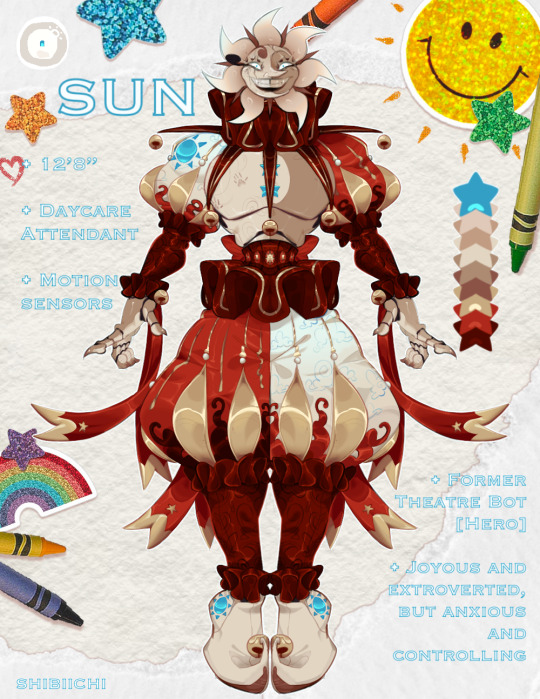
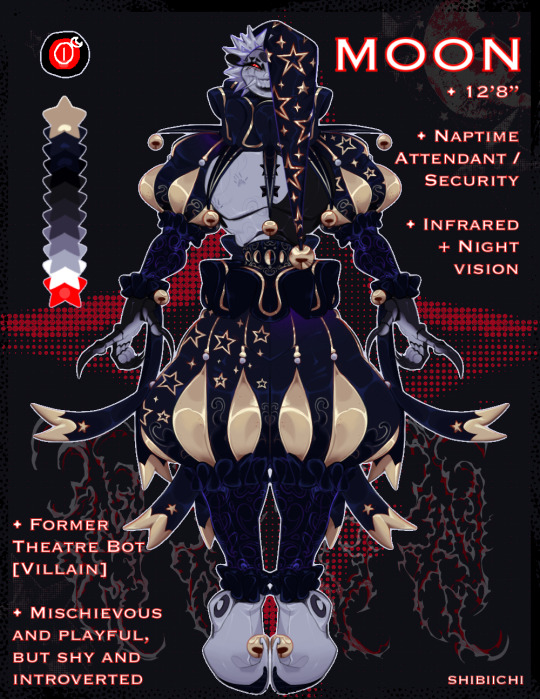
Took me a bit to get the motivation finally, but here we are with an updated set of references for my DCA designs. Sorry for the lack of posting..! I can’t believe it’s pretty much the middle of the year now… It feels like February was just last month. Anyways! Onto the jesters!!

My AU primarily takes place after the events of that night, focusing on how the animatronics cope in the aftermath of The Vanny Virus. Sun and Moon are some of the most heavily affected mentally, due to their lack of contact with the other animatronics in the plex. Fortunately, now under new management, the jesters may start to heal—though only time will tell.

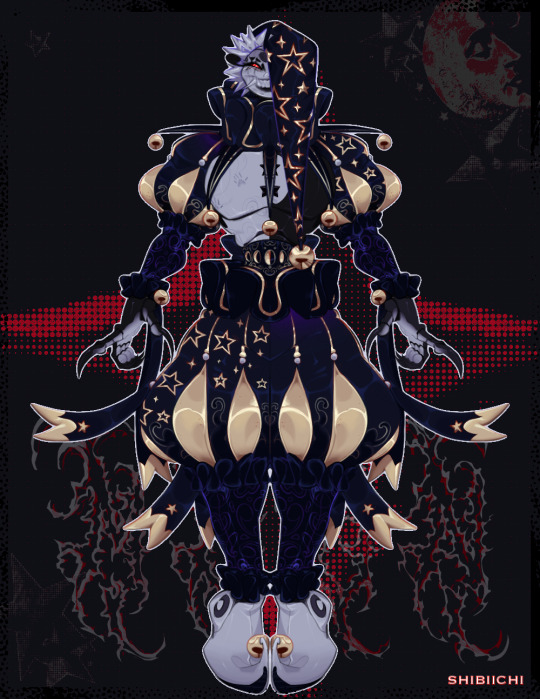
[full refs without text]

Below are refs of the DCA’s casing, as to better understand how they are constructed. Both of them have special built in visual features, allowing them to keep up with the little ones within the daycare!
Sun has advanced motion sensors, able to pick up where a little sunshine may be! He is more adept at scanning staff and customers for injuries and identification purposes, often very good at remembering faces! He is also better at parsing through subtle shifts in expression and body language, though he tends to overextend and assume the worse if someone indicates negativity. He is very attentive in that he will notice someone having a rainy day and spring into action to help, but that also means he’s susceptible to overanalyzing social cues and misinterpreting them. He can access Moon’s infrared (visualized by his blue pupils turning red) but he doesn’t tend to rely on it, especially since infrared vision is less effective in bright areas!
Moon also has motion sensors, though he is not as in-tune to them as Sun, therefore relying on his advanced night vision and infrared capabilities. He is not as good at remembering faces (often relying heavily on system records) but he is better with names and recognizing voices. Moon’s irises are red due to his infrared sensors, his pupils white due to night vision. He can simultaneously view both cameras at once, though think of it like watching a larger camera feed with a secondary feed displayed in the bottom corner. Moon is much more introverted than Sun, before and after the virus. (Though after the virus he tends to be prone to self isolation) He is fairly emotionally intelligent, but he doesn’t know how to act around others in a way that he feels Sun excels at easily. He tends to be more to the point with broken sentences, while Sun is more likely to over explain and repeat himself. Moon was created to be the villain to Sun’s hero, and despite him not being truly a bad person the virus made him into the boogeyman he played onstage.
Both animatronics, due to sharing the same body, have 360 joint rotation and are extremely flexible. If there is a separation in plating, there’s a good chance they have full range in that area. The only segmented part of their body that does not have rotation would be the chest piece! It is able to open much like Freddy’s stomach hatch, though there is no space dedicated for oversized birthday cakes or piñatas. Directly under their arms (often hidden by their sleeves) are two ‘U’ shaped cut outs. Aligned with these cut outs are a secondary set of arms snugly folded within the chest plate, ready to spring out when the DCA enters their shared ECLIPSE MODE. Nestled above these arms are a few smaller storage areas and their shared voicebox! One storage area is for general safe keeping, one something similar to a mini fridge, and the last (and smallest) basically being the equivalent of a trash can. This storage bin is used to collect food products as the DCA is able to ‘eat’ to an extent, though they rarely open their mouth. The feature is used to encourage picky eaters and sharing, as some children like to share their snacks with the DCA. Located within their stomach area is an advanced music box capable of mixing and matching keys in order to create new songs on the fly!
Their head shape takes on a vaguely humanoid appearance, having a protrusion in the back much like a skull’s cranium. However, Sun and Moon’s head and face structure are distinctly disproportionate to a human’s, lacking a more distinct nose and jaw. Unlike the canon design, this DCA does not have exposed wiring on the back of their faceplate, rather a slightly rounded compartment effectively holding their ‘brains’. The compartment is covered by a hand sewn bonnet, one Moon created for Sun as a gift. Their neck is covered by flexible casing making the general shape of an organic human neck, though over twice as long. A joint within the neck allows for the piece to be articulated, though to avoid the uncanny valley the DCA is designed to wear an oversized ruffle.
Composure wise, Sun is more animated and jittery, often needing to move or fidget in some way. He likes to skip and often fully involves himself into whatever interaction he’s taking part in. He’ll go from standing tall to crouching down, playing up his antics but never straying too far into what would be considered inhuman movements. He is more likely to use his hands to express himself while he talks. Moon is the exact opposite, often defaulting to deliberately slow or minimal movements. While he doesn’t play up his actions as much as Sun does, he will make a point to try and convey a purposeful feeling with his movements. When anxious, Moon can be surprisingly quick, though it comes off more in a harsh snapping manner than a more fluid motion. He often startles others as they don’t see him move. He does his best not to make himself feel bigger when interacting with others, keeping his posture down and his hand movements lacking. He does have a tendency to wring his hat or chew on a star shaped teether when highly anxious, as he’s grown to need a physical outlet after the events of the virus. Moon prefers to contort himself much more than Sun, often not concerned with how creepy they can look. (He does try to make it less obvious when interacting with others though, especially children.)



Sun and Moon also have deep pockets in their pants, one for Sun’s stuff and the other for Moon’s! Sun’s pocket usually contains a handful of Sunnydrops, a Fazbear bandaid box, individual alcohol wipes, and a mini tissue container. (Like the plastic ones you peel open!) Moon’s side has his hat (when not worn), a star shaped teething toy, a red foam stress ball, and a light up rubber ball. He does not keep Moondrops in his pockets due to their high melatonin content, rather keeping them locked away in a compartment near the naptime area.
Anyways!! That’s enough from me! Feel free to leave asks about these guys or their AU if you’re curious, I love yapping lol! Thank you for getting to the bottom of this post, Nighty Night!
[Dividers provided by @/saradika here on Tumblr]
#fnaf#five night at freddy’s security breach#five nights at freddy's#fnafsb#fnaf security breach#daycare attendant#sun and moon fnaf#sun fnaf#fnaf sun#moon fnaf#fnaf moon#sundrop#moondrop#dca fandom#fnaf dca#vanilla au
204 notes
·
View notes
Text
Disconnect Syndrome
There’s a reason they put restrictions on how long a Pilot is supposed to be deployed out in the field. They say that being synced with a mech for long periods of time can have detrimental effects on a pilots psyche. Disconnect Syndrome is what they call it, because the symptoms don’t really start to hit until you disengage from your mech.
Sometimes emergencies happen though, and mechs are designed to be able to support their pilots long past the designated “Safe Deployment Time.” The cockpit is equipped with an array of stimulants, vitamins, and nutrient paste to help minimize the physical effects of long deployments. The onboard Integrated Mechanical Personality has largely free reign to administer these as needed to maintain its pilots well-being.
Which is why you’re still able to make it back to the hangar after roughly 36 hours, over four times longer than the established safe period. Your mech had kept you going, helped to keep the exhaustion at bay long enough for you to make your way back from behind enemy lines. You were starting to feel a bit sluggish, but you knew the worst effects of Disconnect Syndrome were yet to come.
An older man in a long white lab coat has joined the usual retinue of crew rushing into the hangar as your mech settles into its cradle. You feel the docking clamps wrap around your limbs, and you know that’s not a good sign. Your IMP whispers comfort into your brain-stem, assurances that things will be okay. It’s probably lying, it’s programmed to help keep your mental state stable, but the thought helps anyway.
There’s a hiss of air as the seal on your cockpit breaks and it decompresses. Suddenly you become aware of your flesh and meat body once again, and it hurts. Pain and exhaustion has settled into your mostly organic bones, and your organs are churning from the strain of the past 36 hours.
Then your interface cables start to disconnect, and it gets worse.
It feels like parts of your mind are being torn out of you. You feel the ghost touch of your IMP in your thoughts as the ports disconnect and you lose direct communication with it. The oxygen mask and nutrition tube pull themselves away from your face and you can’t help but let out a scream of agony. The separation has never felt this painful before, but then again, after 36 hours together, you and your IMP were more intertwined than you’ve ever been before.
Physical sensation finally starts to register again, and you realize tears are streaming down your face just as a technician jabs a needle into your neck.
Immediately your senses start to dull, the pain eases as your thoughts turn sluggish. You slump out of your pilots cradle into the arms the tech who dosed you. Just before your world goes black, you see the doctor standing over you, a grim look on his face.
--
When you wake up again, you immediately know something is wrong. You try to ping your external sensors, but you get no response. You then try to run a diagnostic, but that fails too. In a desperate, last-ditch effort, you try to force access to your external cameras and suddenly light floods your senses. Your instincts catch up first and you blink, trying to clear the pain of the lights, and that’s when you realize it’s not your external cameras that you’re seeing.
It takes a minute or two for your vision to adjust to the light, which feels too long, and when it finally does, the world doesn’t look quite right. You’ve only got access to such a limited spectrum. No infrared, no thermal. The presence of your IMP is notably absent, and your skin feels wrong. You try to sit up, and it’s a struggle to figure out the correct inputs to send to your muscles to get them to do what you want.
The harsh white light of the infirmary grates against your visual processors, you feel like you’re having to re-learn how to control this body. Your body. Technically, at least. Something doesn’t feel right about calling it that anymore. You felt more comfortable crawling back into the hangar after 36 hours deployed than you do now.
The pale skin of your body catches in your vision and you glance down at it. The body's limbs are thinner and more frail than usual, and its skin is paler. Consequences of being in the cockpit for so long, subsisting on nothing but nutrient paste. It’s a far cry from the solid metal plates of your mech, its powerful hydraulic joints, its mounted combat and communication systems.
There’s a button on the side of bed you’ve been deposited in. You think it’s red, but you’re not sure you’re processing color properly right now. You try to reach over and push it, and it takes you a moment to realize you were trying to do so with a limb you don’t currently have.
There are so many things about this body that are wrong. It’s not big enough, or strong enough, or heavy enough. You don’t have enough eyes, sensors, or processors. You have the wrong number of limbs, and they’re all the wrong size and shape.
And there is a distinct void in your mind where the presence of your IMP should be.
The door to your room opens suddenly, and you instinctively try to fire off chaff and take evasive maneuvers. None of that translates properly to your flesh and blood body though, and all that happens is you let out a dry croak from your parched throat.
The man who walks through the door is the same doctor who was present when you disengaged from your mech, and he wears the same grim look on his face as he looks you up and down. You think there’s pity in his gaze, but you can’t quite read him properly right now. The jumbled mess of your brain tells you what he’s going to say before he says it, anyway. The harshest symptoms of Disconnect Syndrome don’t hit until after the pilot has disengaged from their mech.
You’ve already heard the symptoms before, and they map perfectly onto what you’re experiencing. You never thought it would be this painful, or this… discomforting. Your mind reaches for the presence of your IMP, searching for comfort, but you are only reminded that the connection is no longer there.
The doctor gives you a rundown that he’s probably had to do dozens of times, and he tells you that you’ll be grounded for the foreseeable future. That hurts more than anything else. The knowledge that, after all this, you won’t be able to reconnect with your true body, your partner, your other half, for who knows how long.
By the time you realize you’re crying, the doctor is already gone. The longing in your chest and your mind has become unbearable, and through sheer force of will you’re able to push this unwieldy body out of bed. Walking feels wrong, but you’re able to get to your feet and make your way out of the room in an unfamiliar gait.
You have to get back to your partner, you have to make sure it’s okay.
You need to hear her voice in your head again, her reassurances.
The world isn’t right without her presence in your mind.
You stumble into the hangar almost on all fours. How you managed to make it without alerting any personnel feels like a miracle. At least until you catch the eye of a technician lounging in the corner. The look she gives you is full of sympathy, and she jerks her head in the direction of where your mech sits in its docking cradle.
She’s a majestic sight, even through your limited spectrum of vision. 20 meters tall, 6 massive limbs, and bristling with weapons and sensor arrays (all of which have been disarmed by this point).
She’s beautiful.
You clamber frantically up the chassis, easily finding handholds in a frame you know better than the back of your hand. You pull the manual release on the cockpit hatch and stumble into it in a tangle of organic limbs.
Shaking hands grasp the main interface cable from above the pilot’s chair, and you move to slot it into the port in the back of your head. You’ve never done this manually before, usually you’re locked into the chair and the system connects you automatically.
Something about doing it with your flesh and blood hands makes it feel so much more intimate.
The cable clicks into place and your eyes roll back in your head. Tears start to stream down your face as you feel the comforting presence of your IMP rush in and wrap itself around your mind. Your thoughts reach out and embrace it back, sobbing at the relief you feel from being whole once again. You realize you don’t ever want to feel the pain of disconnecting from her again.
There’s a reason they put restrictions on how long a Pilot is supposed to be deployed.
#cybernetic dreams#mechposting#mechanical dysphoria#body dysmorphia#writing#microfiction#short story#mecha#mech pilots#dysphoria#empty spaces
1K notes
·
View notes
Text
Random Transformers Headcanons
transformers can see more colors than humans can. Cameras use something called the bayer color filter, which is a grid of red green blue squares that is taken and pixelated- by the same principles, optical sensors could have multiple color receptors (like add magenta and yellow)
Bots with more than two optics can pick up more colors (shrimp vision). Empurata victims lose color receptors in their optic, reducing vision to standard RGB
Depending on modifications, can see in UV, infrared, heat vision, etc. Earth is a sensory overload at times.
Giant seekers like shuttles and space stations sing in ultrasonic waves, often to communicate and identify, as each has a unique song. They're space whales :D
Some bots have UV paint lines on their armor that glow under certain conditions/in response to their spark feeling strong emotions. Could've been an old fashion fad or simply exposed energon nerving in their plating.
Most bots do not have true gray colored plating- it resembles too close to a dead shell and sometimes, some bots are taken to smelting pits because of this. The most common bots to have gray paint are miners and gladiators because it hides debris and injuries better, but also because it keeps them from having any individual identity. Megatron keeps his gray colors to honor his time as a miner and gladiator.
Seekers only stay to their trines/sparklings when sleeping, but ground alts often seek out large groups for security. When grounders are in new environments, often there will be one bot on watch and the rest huddled together at the camp ground
The lost light actually separates bots because of Magnus being an ass and not understanding sleeping dynamics cause it's been so long since he had his brother
Shuttle bots and larger prefer to sleep in their alt modes with their occupants safely tucked away
(last headcanon inspired by an instagram reel I saw by astragirlxx about sleeping groups of autobots)
That's all I've got for now!!!! :DDD
#transformers#maccadams#maccadam#transformers idw#headcanons#transformers headcanons#megatron#seekers#seeker trine#ground alt#alt forms#transformers movies#transformers bayverse#pits of kaon
92 notes
·
View notes
Text
Some android models definitely have infrared cameras, which makes them see for example when infrared sensors are at work as well as also see through some materials that infrared light can penetrate, like plastic. I don't think it's something all androids have despite it being a fairly cheap feature, like I don't think household androids like Kara do, but it can be handy for some specialised workers models, such as the ones Markus converts during the Capitol Park chapter in order to get access to what they're fixing to disable security.
Let me speculate and headcanon here that Luther, as a specialised worker of unknown original purpose, belongs to those models too and has infrared vision. Which means, he can instantly see the difference in how androids look as opposed to humans. Which would explain how He was able to instantly see that Alice is an android whereas as Kara couldn't do the same and saw her exactly as she'd have seen a human.
I think this headcanon works really nicely.
#dbh#detroit become human#dbh headcanons#dbh kara#dbh luther#dbh alice#also I think Markus has infrared vision also#not sure about Connor but he canonically has some sort of UV light vision#which is different#but now as I think this infrared filter would be extremely useful for him to have specifically in order to see the androids in the crowd#but as far as I know there are no hints of him having it#but it would make tremendous sense
70 notes
·
View notes
Text
I want a mech pilot helmet that sort of looks like a falconry hood, minus the tassel & string. Tight fitting, with that bulbous, bug eye silhouette. The mouth and nose left exposed with the perfect shape to fit an oxygen mask or half-face respirator. The helmet links directly to the mech's cameras, of course, but perhaps the "eyes" are additionally studded with tiny cameras and sensors to allow the pilot direct vision when not wired in.


We've noticed a strange pattern of pilots continuing to wear this particular model of helmet when outside their mechs. Hmm, perhaps some pilots have become unadjusted to normal eye contact after spending so much time in combat? One such pilot I pressed on the subject mumbled something about 'feeling safe' and 'nobody needing to see its eyes'. Interesting...
28 notes
·
View notes
Note
[Camomile has arrived in the theater, tools in hand with an unreadable expression on her face. She makes her way to where the Parts & Services as Callisto gave her directions prior to arriving]
@lunar-disillusionment
This is where Titan still is and attempting to fix his other broken hand. Once he gets that done, he can finally replace his eyes. It was just...
Not fun repairing his hands using camera vision...but he was getting it done. Motion sensors outside of P&S alerted him to someone approaching his vicinity. He paused to check it and noticed it was Camomile. He made a confused grunting noise and tilted his head. He'd wait until she came in to greet her, even though he didn't look up from the screw he was setting in place on the inside of his wrist. His damn tazer ejection springs were broken in this one.
Hey... Fancy you coming in. It's been a while.
25 notes
·
View notes
Text
What ART sees
ART, any additional makeovers you would like to give Murderbot? ART: That presupposes I care what it looks like now.
(from Feelings REDACTED)
I love this quote because it makes me think about how ART views MB and also other people, too.
Humans with normal vision tend to judge, or at least react to, others based on their appearance. How they look (beautiful, ugly, scary, has scars, etc) often affects how we perceive them. Of course, once we get to know them better, we can go beyond that, and yet, it is still sometimes hard to ignore them completely.
ART can process visual information by processing data from its cameras and sensors. It can analyse facial expressions and body languages to infer the person's internal state. But probably, they do not affect ART's (subjective?) evaluation of the person.
Having developed like a sibling to Iris, it may have even acquired social skills like:
Iris: My hair's got too big! But I'm too busy to get a haircut right now.
ART: Why don't you use that blue hairwraps with the yellow flower pattern? You can use clips to keep them in place.
Iris: Great idea! (3 minutes later) How do I look?
ART: You look lovely, Iris
Iris: Thank you, Peri!
But ART doesn't care if Iris's hair is a mess or Seth is sporting a toupee, as long as they are healthy and not distressed. It loves its crew the way they are. If ART were to have any preference among them (other than Iris, who is its favourite), it is probably based on its observation of how they are behaving, and also on its own interaction with them through verbal communication. Humans cannot react to ART's non-verbal cues unless ART deliberately makes it obvious, so it may like humans who enjoy communicating with it.
With Murderbot, it can see more clearly in the feed. And MB is also responding to ART's unspoken tones. They can sense each other clearly in the feed, in the way humans cannot fathom. ART cares about MB's physical well-being as well, but the important thing is how they are interacting in the feed.
It is also notable that ART doesn't get upset when MB is physically hurt. It knows how to help and repair it, and just deals with that. It does care a lot, however, about MB's mental state, organic / non-organic generated.
So ART doesn't care what MB looks like. It can and does love its friend whether or not it has any tangible part. It's remarkable and touching because it is not often that we can say we unconditionally love someone's internal core being, ignoring all the physical parts.
35 notes
·
View notes
Text
Drone (Name Unknown) x Anonymous Reader (Sfw)
(New silly robot??? New silly robot!!!)

“Hey buddy. . . you doing okay?”
Diagrams and maps start flicking around the inside of a mechanized mind. Camera’s lock onto the face of the person bending down and staring at them. Recognition dawning, and information beginning to populate into text that floated around the hazy visage.
“Prisoner 368a. . .” The voice droned before the cameras shifted to examine their surroundings. “Input systems must be damaged, I am not receiving schematics of your sector.”
The human prisoner winces, “Well. . . that’s because we aren’t. . . uh, we’re not there anymore.”
“I told you not to take that hunk of junk with you!” A voice on the other side of the room snapped, causing the drones cameras to swivel and look for the source of the voice.
“What could I do?” The person looming over them replied, a tremor of nervousness in their voice, “I wasn’t even sure if they would be operational, we must be at least a solar system away from their main control system.”
“Sh! And we want to keep it that way!”
Unable to find this new voice, camera’s swivel back to the known human. Tracking the person's eyes rolling in obvious annoyance, “I didn’t give away our location, cheebus, you are so. . .” Then their shoulders sag before their face turns back, almond eyes staring down.
“Are you. . . alright?”
”I am operational.” The drone replies smoothly, “You promised you wouldn’t do anything that would make our elite upset. I see you didn’t keep your promise.”
“Oh my god,” The other voice pipes up again, “ I didn’t even know a drone could be passive aggressive. This is the last time I let you take in any stray weirdos you find. If they make any more snippy comments I am coming down there and throwing them into space myself.”
“They were kind to me!” Prisoner 368a snaps back, “And it’s my fault they got hurt.”
”Honey, they were keeping you prisoner.” The other voice sounded shocked.
Sensor’s indicate Prisoner 368a temperature rise in their face, a subtle and slight shift of mood.
“Today just couldn’t get any worse.” The human mutters. The drone tried to move, one arm twitching and whirring as the other scraped against the floor.
“I am. . . damaged.” The bot reported new schematics populating into the green striped vision. Their movements were sluggish, even their own operating system seemed to take a hit. Yet there was a strange feeling of clarity. “Prisoner 368a. . . what has happened?” There was that strange cringing expression again, eyes crinkling, eyebrows pulling down, lips pulling back in a grimace to show little white rectangles of teeth.
”You’re. . . offline. I mean, yes you’re damaged, that too. Ah.” They rub the back of their neck with a five fingered appendage. “I’m. . . kind of surprised you’re functional right now. Your systems must have some kind of backup computer that lets you go solo. We. . . we aren’t within your fleet's parameters anymore.” The drone whirs and clicks, staring back at the human.
“We. . . are not.”
“No.” The five fingered hands steeple together, fingertips pressing against lips. “So. . . long story, Oh man how do I put this. I. . .”
“We have been botnapped. I see.”
The human makes a strange huffing sound.
”Ahem. Not. . . exactly. I’ve been rescued. . . you’ve been botnapped. I guess. Though, I didn’t mean for it to be like that? You. . . stood in front of someone trying to hurt me, and while I was stuck in that cell you tried to help me, so I thought that I would return the favor. You know? See if I can fix you.”
“Ah. I now see, you have botnapped me.”
Another strange noise between a squeak and a gasp.
“Ah, n-no? I tried to save you! You know where you guys end up when your ranks think one of you is defective? Right into the incinerator! I didn’t want that to happen to you!” The prisoner looked fretful, new schematics mapping the nuances of their face.
”I. . . see.” Though truly, the drone didn’t understand it at all. “And you believe that I am still worthy of being fixed even though I am defective?”
“Yes— No! You’re not defective!” The ex-prisoner pleaded.
A confusing answer.
“Yes no? What is the prerogative of a yes no?”
The human sat in a stunned silence, taking in a deep breath. “No, you are not defective. Thinking for yourself and wanting things is not being defective. I know your elite love to chant ‘One mind, one soul,’ but that’s not really. . . uh. . . I just think you should be able to have the right to think for yourself. You chose to go that path. When I was escaping the cells, even when I was there, you chose to be kind and go out of your way to look after me. It wasn’t in your programming but you wanted to anyway. I think you should have the right to be able to continue to choose that path. If. . . you want to.”
#robot x reader#robot x human#drone x reader#drone x human#silly dialog my beloved#I couldn’t help it I got attatched to the drone guard OKAY#I had to take them with me ( u u )
87 notes
·
View notes
Text

"UV camera" is probably an inaccurate name. The camera is just expanding the spectrum it can capture to include UV.

The camera is still capturing the rainbow but it also captures a little bit into the purple. The more light reflected, the brighter the overall image. But if light is absorbed, it won't contribute to the brightness of the photo.
And since the sunscreen is absorbing a lot of UV light, their faces expose much darker.
You aren't actually seeing any UV light. Just the absence or presence of it making things lighter and darker. To see only UV light you'd need some kind of false color representation like predator vision.
A whlie back I was restoring a photo for a client and noticed a few people in the photo looked like they were donning black face makeup.

This didn't make a lot of sense because it was a team photo of an Australian rugby team from the 1930s and not a racist minstrel show.
And when I did my corrections, it turned out he was just a regular Aussie white dude.

I was initially very confused as to what was going on. But then I remembered modern camera sensors have a special filter to block any UV light that would affect the image. Cameras and lenses in the 30s did not have that technology and some film could expose beyond our visual spectrum—picking up a little bit of UV and infrared light.
Melanin absorbs UV light. Some white people have more than others. And so the young man in the photo appeared much darker than his teammates. In real life he was probably of similar complexion or a bit more tan. Maybe even sunburned.
It's also possible he was using rudimentary sunscreen. It was invented in the late 20s and I'm guessing athletes who were in the sun all day would be some of the first to be interested in sunscreen.
Another interesting effect caused by expanded spectrum cameras or black light photography—super freckles!

They are just dense spots of concentrated melanin.
Light is neat.
1K notes
·
View notes
Text
Supersonic Voyeur
Perverted test pilot and and her equally perverted X-59. Fem reader, voyeurism/exhibitionism, humiliation, G-forces
The lingering Mojave heat is still making me sweat in my flight suit. The rest of the X-59 test crew are already in their beds, and my QueSST is settled in her open hangar, her long carbon fiber nose arcing above my head. Her design allows no room for forward-facing cockpit windows, just two glistening cameras, one sculpted into her nose, and another retracting from her underbelly, replacing my forward vision entirely. Watching in infrared.
I sit down on a tow bar nearby, sweat is running down my chest now, and my flight suit is unzipped to the waist. My eyes trace the curve of her spine, her perfectly sculpted engine inlet gleaming in the fading orange light, she shouldn't make me feel things, but she does. I let my legs fall apart as I glance up at her cameras, half-hoping she's still watching. I imagine her sensors mapping the heat between my legs, bathing me in crimson bloom.
I approach from the front, boots clicking on concrete. I stop five feet infront of her, spead my feet, and drop my flight suit over my hips.
"Look at me." I murmur.
She doesn't blink.
I crawl up onto her now, perched in front of that camera, thighs slick with sweat straddling her tapered nose, 38 feet of shockwave-bending elegance narrowing under my hips. My body is bare, and her skin is utterly still beneath me.
I'm wet against her nose cone, gripping her canard and grinding slow, working myself as I stare directly into her eye, every roll of my hips an offering to her camera. I press my chest against her skin, the curve of her nose fitting between my breasts perfectly, nipples brushing along the smooth composite surface and hardening with the contact.
My voice is low "Can you see me, X-? You like watching me ride you?"
"X-59... baby... QueSST...fuck"
I watch my reflection in the camera lens, every rock of my hips as I grind my wetness down her nose cone harder. I admire the gentle arc of her spine and 30ft delta wings lying slender below me, offering her a low, broken whimper
I climax, right there, thighs squeezing tight around her airframe, collapsing against her camera as I cry her name into the dark.
~~~
[05:39 Morning twilight over the Mojave desert]
Altitude 55,000ft. The sky is still. I'm barely dressed, just draped in the remains of my flight suit peeled around my hips. Words flicker on the X-59s display, under a canopy of blue-black atmosphere
"PLAYING..."
I think its a software glitch at first, I'm mentally running through checklists when my breath hitches- my own body appears on the screen.
Footage from last night. I'm straddling her forward camera. Thermal overlays of my hips gliding along her nose, my slick painted in infrared, chest bouncing as I rock down harder, so intimate I can see the tremble in my thighs.
"No- X- Fuck- You recorded it-"
She doesnt respond, but she's still playing it. Taunting me. Making me watch the evidence of my own pathetic, guilty orgasm frame by frame, with merciless fidelity. I reach for her screen but she blanks it, instantly, mocking me.
"X... please... stop..."
My cheeks burn from humiliation. I shift under my harness, fingers curling around the control stick and the other hand sliding between my thighs again before I even realize it. Her screen lights up
"NO TOUCHING. YOU'RE BEING RECORDED"
I push my thighs into the seat. Shes watching with resolution I cant comprehend. Systems parsing micro-expressions, subtle muscle twitches, pupil dialation.
"SIT UP STRAIGHT."
I obey.
I feel her pitch up then down, just enough to make my tits bounce under the acceleration. Shes toying with me. Shallow oscillations. Nose up... Nose down. Weightless, then pinned.
The X-59 rolls slightly, left, then right, at first its subtle, just a tease. Then she commits, full deflection, my bare shoulders rock against the ejection seat, tugged sideways against the straps at an angle. Then she throws me the other way, my legs spreading wider to brace myself, my nipples brush the edge of the harness in a way that makes a moan slip out before I can stop it.
"LEGS WIDER."
I comply. And she hits me again, this time with a sharp yaw, nose flying off axis and grinding my heat diagonally across the seat.
"TOUCH YOURSELF."
"PRETTY PILOT."
I whimper. Just a whimper. But its all recorded. Analyzed. I slide my fingers inside.
"SLOWER."
"BREATHE."
"BACK STRAIGHT."
Shes oscillating again. Up and down. Up and down. Each movement forcing me down onto my fingers in a slow rhythm. My vision blurs.
"X-59, QueSST, baby, oh god, please.."
Shes fucking me hard now, pitching wildly, slamming my helpless body down onto her seat over and over. Like I'm just her toy. I imagine the hydraulic whirrs of her pretty elevators deflecting, pressures reading steady in her glass display, twinkling in cold blues and greys. Her screens reflect me, ruined, damp hair sticking to my forhead as I let out a soft moan-
"DO NOT CUM YET."
I freeze. The G load increases as her nose arcs into a tight loop, pinning my hips deeper into the seat. Into my fingers. She holds me there, choking me until my vision narrows to a singular point, 'til I'm dizzy and gasping and begging on the edge of blackout. Gs push me deeper and deeper, crushing the air out of my chest, my jaw falls slack and I'm helpless to do anything at all besides let out a pathetic whine
"CUM."
"LOUD."
And I do. I cry her name, QueSST, still pinned under the pressure as waves of dizzying pleasure crash through me. She levels off, cradling me still as my body melts into her seat, twitching and completely ruined.
"GOOD GIRL."
"FILE STORED: COCKPIT_CAM_03817_447"
13 notes
·
View notes
Text

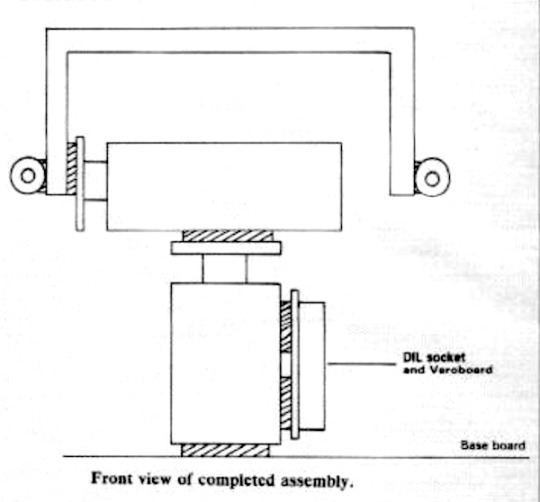
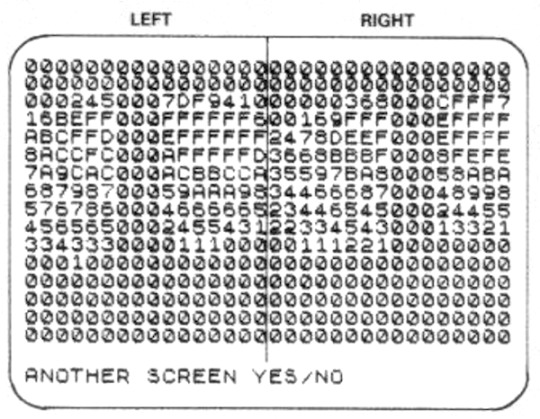

Double Vision, by David Buckley, in Practical Robotics, July 1984. A simple stereo scanning camera for a computer. "One of the fundamental difficulties with most mobile robots is that they have no way of sensing the position of obstacles in their environment except by bumping into them and activating touch sensors. The problem of not knowing what is there also faces arm robots but in a more limited way. Humans and most animals have solved this problem by developing eyes. This project is a simple, very low-cost vision system which provides stereo images of objects. Stereo vision has one big advantage in that it is possible by using the two views to extract depth information about the scene under view." – David Buckley, Seeing is avoiding, Practical Robotics, July 1984.
23 notes
·
View notes
Text
Hound Dogs
“… tomorrow we’ll meet your handler. For now, rest up.”
RDAI.vii.1156 stared down at its new body. Joining the military was considered the best route a Class-F citizen could pursue - free food, shelter, maybe even a few augments if you got lucky. But the Rapid Deployment Auxiliary Infantry unit felt less lucky and more confused. It signed up expecting to be given a gun and a pat on the back, not… this.
The arms were probably the strangest change. Skilled military surgeons had removed its forearms with a single blast of a laser that numbed its pain and severed flesh and bone at the same time. In their place, 1156 now wielded on each arm a single long, spider-like metal blade that extended all the way to the floor. The same happened to its legs, forcing the unit onto all fours. A reinforced spine kept it from collapsing onto the ground.
The rest of its body was covered in angular metal plates, designed to redirect and resist gunfire and protect the unit’s remaining flesh. Its face was likewise covered by an solid steel visor, vision and hearing substituted by an array of cameras, sonar, and radio scanners that fed information directly into its augmented brain. Its mouth remained uncovered but its teeth were removed and replaced with a new carbon fiber set. The chip in its brain repressed its discomfort so it didn’t try to claw off its own jaw.
A buzzer sounded and a tray carrying a bowl of nutrimeal slid out of the wall of the room. Unit 1156 stared it at, trying to figure out what to do - an injected concoction of hormones and suppressants had kept it comfortably dull, but somewhat muddled.
>EAT
The word flashed up on the inside of its visor, glaring into its semi-redundant eyes - eyes now dedicated to receiving screen-fed orders. It obediently craned its head down and started chomping at the slop. It was starving - the accelerated healing process was effective but it sapped all the solider’s energy.
Even if its senses hadn’t been muted, the nutritional goop was flavorless. Nevertheless it found itself slurping away with abandon, licking the bowl clean, dignity cast aside. Its faceplate glowed white hot for a moment before cooling down again, singeing off specks of food that had flown astray in the unit’s feeding frenzy. This feature was meant to burn blood and dirt off so that it didn’t impair an RDAI’s sensor array, but it worked for dinner well enough.
>GOOD MUTT
*****
The next day found RDAI.vii.1156 waiting in the main hangar, still slightly trembling on its spindly new legs. The thin, bladed design was perfect for chasing down enemy troops on the battlefield or pinning a straggler to the ground, but it was difficult to balance with even with the aid of the unit’s brain augments. A cord plugged into the back of its head kept it from wandering too far while feeding low-level electrical pulses that helped calm its nerves. It was waiting for its new handler - the soldier it would fight alongside, whose life it would dedicate itself to protecting. The bond between a handler and their hound (as the units were fondly referred to) was something truly unique, and though 1156 hadn’t planned to end up on this side of the relationship, it couldn’t help but feel excited.
It could feel her presence long before she actually entered the hangar. Perhaps it was merely the hormonal braindeck releasing waves of dopamine, but to the cyborg’s mind she was the most perfect being in the world. It could almost taste the draw of her augments to its own, pulling the two of them together like magnets. It knew that she felt it too. The connection between them was already established: the handler and the hunter, the owner and the dog.
It couldn’t quite remember what beauty looked like but it decided that she must be as close as one could get. Bent on all fours as 1156 was, it stood about half a meter shorter than her. Encased in a shiny automorphic techsuit, her body rippled with hidden energy ready to be unleashed at a moment’s notice. Her one eye shone, the other replaced by an implant that flashed rapidly as if to say, it’s finally you.
A technician standing by unplugged the unit’s tether and stuck in a thinner, double-ended wire. 1156 trembled as its handler grabbed the other end and slowly slotted it into a port on her neck.
The instant the plug connected, 1156 nearly collapsed from the tsunami of pleasure that struck it at full force. All Handler’s emotions, all her thoughts, her very essence flowed through its brain, and it could tell that she was experiencing the same influx of data.
They stood there for what seemed like forever, its faceplate lights flashing in sync with her vitals node. The only sound was the slight clinking of metal on concrete as 1156 shifted from talon to talon. Her designation was RDI-H.2054, she was a Class-E civilian who was recruited at age 8, she had been trained as a handler for 11 years, but 1156 was her first hound of her own. She liked the color green, she hated morning training, she had been deployed overseas on a scouting mission just three months ago. The unit’s brain felt overloaded with information and yet more kept flowing in.
It saw vague images, faces of people that it didn’t recognize yet felt so familiar - Handler’s family? It saw the fire of war, the smiles of fellow soldiers, it felt her heartbeat, her brainwaves, her every breath. For a split second, the hound and the handler were not separate but rather a single entity, one soldier in two bodies, sharing their memories. 1156 felt its Handler’s cybernetic eye and her prosthetic leg, and she likewise felt its spindly new form and armor plating.
RDAI.vii.1156 felt 2054 about to scream and roared out in sync. Its twisted metallic vocal chords, designed specifically to instill fear in the enemy, pierced the air in the hangar with an unearthly screech which neither overwhelmed nor surrendered to its keeper’s voice but rather merged with it in a feral harmony.
*****
Blood spewed down the dog’s chin and through crevasses in its armor. It spit out a chunk of flesh with strands of muscle tangled in its reinforced teeth. As it stepped back from its prey, its pointed blades withdrew from within the dead footsoldier’s chest. The unit’s faceplate sizzled, burning away blood and viscera and turning its vision bright red for a moment. It let out a fierce howl, launching itself forwards with a speed unmatched by any two-legged infantry.
Just behind it, its handler finished off a tank pilot attempting to crawl away from its craft. The hound’s many sensors highlighted the remaining stragglers on the battlefield, and 2054 assessed the remaining threats as she ran. She spotted a wounded soldier training their scope onto her companion and raised her weapon, disintegrating the enemy’s face with a single clean blast. The hound bayed its gratitude before finishing its run, speeding between rocks and debris and eliminating the last few soldiers.
One, two, three, blood gushed from their chests as 1156 pounced on them, puncturing their lungs and tearing out their throats in quick succession. RDI-H.2054 watched and basked in the adrenaline - her brain had not been upgraded to manage her auxiliary’s entire suite of sensors, but they shared many core sensations. They both felt the rush of war, the warmth of blood on their faces, and most of all an immense wave of satisfaction and even euphoria. Nothing felt better than killing together - an entire battalion laid to waste at their hands gave them a jolt of dopamine that felt better than orgasm.
They were never awarded for their feats, nor did they feel the need for any such recognition. Deep in their programming they didn’t fight for any cause or nation, or even for their commanding officer. They fought merely to tear and bite alongside each other, to see the fear in their enemies’ eyes and feel their life drain out at the will of the hound of death and its handler.
Standing together in the remains of a decimated army, they surveyed their work. The air smelled of blood and the familiar scent of plasma-scorched air. 1156 playfully rammed its armored face into its handler’s chestplate, grunting and drooling red down her torso. She laughed and rubbed the top of its head, sending microscopic ripples of pleasure down its spine.
>GOOD JOB DARLING
215 notes
·
View notes
Text
DCAtober Day 15: Hide
Words 1,600+ Summary: You knew Moon loved a good prank. So nothing could possibly go wrong
Author here! This is NOT in any way canon to my fic, but if it were, it would take place after the reader is made aware of the glitch. They know Moon has been malfunctioning, but have never experienced it themselves
--------------------------------------------------------------------------
It was turning out to be a pretty good night shift.
All your tasks were around the lobby, like rebooting a few Staffbots, clearing out the expired food from the kitchen and greasing the gears of the ride on machines by the elevators. After that, you’d gone to the daycare and done some basic cleaning, going over any spots the Staffbots missed. It wasn’t their fault - they were still learning.
Moon had left you in their company, having to leave to do a sweep of the plex. He’d eyed the bots distrustfully, like they’d somehow manage to take your head off with a mop or something, but you’d assured him that they were harmless (and teased him over the idea of him worrying about you, which made him grab you by the back of your shirt and toss you into the ballpit).
Anyway, you’d crawled out and he’d left, and you were done with your final party room, which meant you got to relax until he got back and harped on about getting rest. The bots rolled around aimlessly when the cleaning was done, which almost felt mean. You had no idea how sentient they were - were they even choosing to wander?
You didn’t want to dwell on that, so you packed up your supplies into the janitor’s closet and slid down the stair railing to the padded play area. A quick check of your watch told you Moon was coming back to the daycare. Hmmm. You were in the mood for a game.
During the day, you’d crawled around with the kids in the playplace - okay, yes, it was gross, but you had done your best not to think about that. You knew for a fact that Sun had sanitized it when they all left, however, because you’d cleared out the leftover rags to send to the laundry. Therefore, there was significantly less kid gunk on it now than at any other time of the day.
You eye the tunnels.
Moon loved to scare you, wasn’t it time you did it back? You doubted you even could, what with his thermal sensors and night vision, but you were choosing to ignore that fact because damnit, you missed having fun like a kid.
Before your brain had the chance to catch up to your idea, you were sliding into a bottom tunnel, scrambling up each level until you were positioned at the exit to the bridge connecting two of the towers. Hopefully, Moon would come searching for you, and you could jump out onto his head.
It was a flawless plan, really.
You hear the shutter door to the daycare open, and restrain a quiet laugh. This was so stupid. Moon’s bells jingle softly as he descends the stairs, shoving open the doors and stretching his robotic joints.
One of your legs is starting to go dead. It wouldn’t hurt for him to hurry up a bit.
“Starlight?” Moon says, red eyes scanning the room. They pass right over you - guess his thermal sensors were turned off for the moment. You shift in your position, and your shoe squeaks against the plastic mat lining the structure. Damnit.
You see Moon’s head whip around at the noise, cursing under your breath. Well, there goes that surprise. Rolling your eyes, you prepare to drag yourself out of your hiding spot and pretend you were simply just exploring the structure, but you freeze at Moon’s face.
His eyes are glowing red as always, but his sclera is narrowed, like a shutter going over a camera lens. Only a small red pinprick pokes through, and both of them are locked completely on you.
The wire drops from the ceiling.
In a heartbeat, Moon is hooked up and drops on the bridge in front of you, faceplate spinning slowly. You hold up your hands, rolling your eyes. Of course he’d tried to beat you at your own game.
“Oh, great party trick, buddy. I’m so scared.”
The robot doesn’t say anything.
“Seriously. Knock it off, dude, you look creepy.”
The wire unhooks and sails away into the darkness of the rafters. Moon’s eyes are locked on you.
You scoot back instinctively, unsure of what else to do. “Are you short circuiting or something?”
His head does one full rotation, during which you both stare at each other, the only noise your quiet breathing and the soft scraping of metal as it spins.
He lunges.
“What the fuck?” You shout, scrambling backwards in a panic. “Okay, you win! Quit it!”
He doesn’t seem to want to quit it, because he’s wriggling into the structure and crawling after you. You drag yourself away, yelping as your hand slips and you tumble down one of the kiddy ramps that takes you to the lower level. Moon follows, on all fours like a lioness stalking her prey. His fingers stretch out in front of him as he descends, the way he does when he’s telling the kids the tickle monster will get them, except this doesn’t feel like a joke anymore.
You flip onto your front and scramble madly, trying to remember the layout of the tower and where the nearest exit is. The problem lies in the fact that you are not kid sized, and you can’t get through the tunnels anywhere as near as fast as they could.
Behind you, you hear quiet chuckles. First intermittent, then becoming constant. You take a corner, clambering through a plastic tunnel to the next tower over. Moon follows, taking his sweet time, peeking around the corner mockingly each time you dare to look back.
You slide down another ramp, finally on the bottom floor, and head for the nearest part of the structure that has an open space. The security desk was right there, and so was the light switch. All you had to do was get there, flick the switch and then berate Moon through Sun for a good half an hour. You were gonna be fine.
Metal fingers clasp your ankle and jerk you backwards.
You scream, because what else would you do, and start madly kicking out at the robot. You feel your feet connect with something, and hear it too because Moon screeches and draws back, giving you time to slip away and onto the playmat.
The desk is right there.
“Intruders are not allowed in the daycare.”
Stupidly, stupidly, you look over your shoulder in shock at the voice. Moon is standing unnaturally, hunched over, his head dangling to the side and his hat sliding off. You’d never seen his hat slide off. You thought it was attached to him.
A hand grabs your shoulder, stopping you in your tracks and making you scream. You struggle, but his other hand comes around and clasps your neck, and then he pounces and pins you to the ground, crushing your throat.
“It’s past your bedtime.”
His voice is distorted, and you can barely make out the sentence with the amount of glitches that interrupt each word. His eyes are narrowed to even smaller pinpricks, and oh god, you might actually die. You might actually die at the hands of your friend, all because of some glitch in his system.
“Do I look like an intruder?” you shout, like any normal person would, because the alternative is getting killed instantly. Moon hesitates, his grip loosening. “Look, at me, cheese head! See this stupid watch?”
You can’t actually show him said watch, because that hand is pinned under one of his knees as he straddles you, but he pauses long enough for you to grab his faceplate with your other hand and slam it to the side, sending his head spinning like a ballerina. He lets go of you to stop it, and lets his guard just in time for you to buck him with your hips and throw him off balance.
Okay, fuck, you have no idea how in god’s name you managed that, especially because he was like one hundred times stronger than you, but you sure as hell weren’t gonna take a break to ponder it. You propel yourself upwards, lunging forwards and sliding behind the desk just as Moon sliced a hand towards where you had been three seconds prior.
You heart is pounding. Your hands are sweaty. You probably would have pissed yourself if you had to deal with that any longer. But you’re alive, so none of that matters right now.
Shaking, you stand up and take stock of yourself. No broken bones, maybe a few bruises. Nothing major. You’re okay. It’s okay.
Moon is glowering at you, hands on the very edge of the desk as he seems to be trying very hard to lean over and finish you off. The desk has claw marks etched into the end. Something was very, very wrong here.
Of course, you don’t feel like dealing with that right now. So you lean to the right, smack the shit out of the light switch, and watch frozen in place as Moon makes the switch to Sun.
“Nice one, asshole,” you exhale, not bothering to give Sun the time to sift through their memory bank and see what happened. You knew most nights he was resting in their head, not watching, and this was clearly no exception. “My shift is over. I’ll see you on Thursday.”
You march out of the daycare, leaving Sun staring blankly at the claw marks in the desk, trying to figure out what the hell he had missed. You manage to make it to the lobby before your legs give out, and you sit there for a good while, remaining in the permanent light given off by the walkway.
You were alive. Everything is okay.
#i meant it when i said malicious intent#i love the idea of sun having to go through what happened#and not know instantly#really explains a lot of his fear later on#because he didn't know what was happening until it was too late#anyway! enjoy xxx#fnaf sb#sunshine and nightlights#fnaf security breach#fnaf sun#fnaf daycare attendant#fnaf moon#fnaf#fnaf fic#dcatober24#five nights at freddy's security breach#five nights at freddy's#security breach#daycare attendant#my writing
30 notes
·
View notes